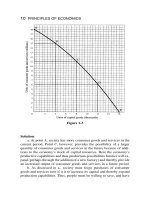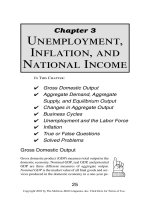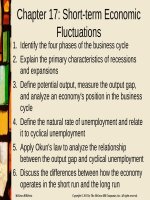individual assignment 2 3 course principles of economics eco121
Bạn đang xem bản rút gọn của tài liệu. Xem và tải ngay bản đầy đủ của tài liệu tại đây (1.71 MB, 30 trang )
<span class="text_page_counter">Trang 1</span><div class="page_container" data-page="1">
FPT UNIVERSITY - CAN THO CAMPUS
INDIVIDUAL ASSIGNMENT 2 - 3
COURSE : PRINCIPLES OF ECONOMICS – ECO121 CLASS: IB1805
Instructors: Đoàn Hoài Nhân
Student: Huỳnh Thái Khang – CS180719
Can Tho, October 2024
</div><span class="text_page_counter">Trang 2</span><div class="page_container" data-page="2">I. Answer key.Question 1:
a) Individuals adopt new habits, cut back on spending, and increase their savings.
- Impact on the real interest rate: Increased savings by individuals implies a higher supply of loanable funds in the market. This surplus of funds pushes down the equilibrium real interest rate as lenders compete to attract borrowers.
- Impact on the level of investment: The increase in the real interest rate makes borrowing more expensive for businesses seeking funds for investment purposes. Consequently, the level of investment decreases as firms are deterred by the higher borrowing costs associated with the increased real interest rate.
- Conclusion: Increased saving by individuals leads to a higher supply of loanable funds and a decrease in the real interest rate, while the level of investment decreases due to higher borrowing costs for firms.
b) Business firms are pessimistic about future economic perspectives.
- Impact on real interest rate: The pessimism among business firms may lead to a decrease in investment demand, causing a reduction in the demand for loanable funds. This decrease in demand could potentially lower the equilibrium real interest rate, depending on themagnitude of the decrease in investment demand.
- Impact on the level of investment: The decrease in investment demand results in a reduced level of investment as firms postpone or scale back their investment plans due to the gloomy economic outlook.
- Conclusion: Pessimism among business firms may decrease investment demand, potentially lowering the real interest rate and subsequently reducing the level of investment.
c) The government provides a more attractive investment environment.
- Impact on real interest rate: A more attractive investment environment, perhaps through policies such as deregulation or tax incentives, stimulates investment demand. This increased demand for funds pushes up the real interest rate as borrowers compete for available loanable funds.
- Impact on the level of investment: The higher real interest rate
</div><span class="text_page_counter">Trang 3</span><div class="page_container" data-page="3">incentivizes greater investment by firms as the cost of borrowing decreases. Consequently, the level of investment in the economy increases.
- Conclusion: A more attractive investment environment stimulatesinvestment demand, raising the real interest rate and increasing the level of investment in the economy.
d) The government decreases its spending on education.
- Effect on the real interest rate: The loanable funds market may notbe significantly impacted by the government's decision to cut education spending. On the other hand, this reduction may result in a decline in investment demand, which could lower the equilibrium real interest rate, if it has an impact on long-term productivity and economic development prospects.
- Impact on the amount of investment: Lower government educationspending may impede the development of human capital and the improvement of technology, which would eventually stifle the rise in productivity. Due to the decreased likelihood of future returns on investment, businesses may decide to make less investments as a result.
- In conclusion, cutting back on government education spending might not have an immediate effect on the real interest rate, but it might eventually reduce demand for investments, which might lowerthe real interest rate and lower the amount invested.
e) The government implements an expansive fiscal policy. - Impact on real interest rate: Expansionary fiscal policy involves increased government borrowing to finance expenditure, thereby augmenting the demand for loanable funds. This heightened demand exerts upward pressure on the real interest rate.. - Effect on investment level: As a result of the expansionary fiscal policy's higher real interest rates, which make borrowing more expensive for businesses, investment levels decline. - In summary, an expansionary fiscal policy results in more government borrowing, an increase in the real interest rate, and a decline in investment as a result of higher borrowing costs for businesses.
f) The government implements a contractionary budgetary policy.
- Impact on real interest rate: Contractionary fiscal policy lowers
</div><span class="text_page_counter">Trang 4</span><div class="page_container" data-page="4">government borrowing, which lowers the demand for loanable funds,in contrast to expansionary fiscal policy. The real interest rate tends to decline as a result of this decline in demand.
- Impact on investment level: As borrowing becomes less expensive due to reduced real interest rates, businesses are encouraged to take on additional investment projects. As a result, the economy receives more investments.
- In summary, a contractionary fiscal policy lowers government borrowing, which in turn lowers the real interest rate and boosts investment by lowering business borrowing costs.
g) The government implements monetary expansion: - Effect on real interest rate: An expansionary monetary policy reduces the nominal interest rate by expanding the money supply. The real interest rate drops as inflation expectations change, which increases demand for investments.
- Impact on the amount of investment: An expansionary monetary policy's lower real interest rates make borrowing cheaper for businesses, which in turn spurs more investment activity and raises the amount of investment in the economy.
- In conclusion, an expansionary monetary policy lowers the real interest rate, which boosts demand for investments and raises overall economic investment levels.
h) Contractionary monetary policy is implemented by the government:
- Effect on real interest rate: A contractionary monetary policy raisesthe nominal interest rate by decreasing the money supply. After accounting for inflation expectations, this rise in the nominal interestrate leads to an increase in the real interest rate.
- Effect on investment level: As a result of making borrowing more expensive for businesses, higher real interest rates reduce investment activity. Consequently, the economy receives less investment.
- In conclusion, contractionary monetary policy raises the real interest rate, which reduces the amount of investment in the economy and dampens investment demand.
Question 2:
a) Individuals adopt new habits, cut back on consumption, and increase their savings:
</div><span class="text_page_counter">Trang 5</span><div class="page_container" data-page="5">- People alter their habits, cut back on their consumption, and increase their savings:
Effect on trade balance: Higher personal savings rates are indicative of higher domestic savings rates. This higher inclination to save can draw foreign investment and result in capital inflows in a small open economy with free capital mobility. As a result, the value of the local currency increases due to greater demand. As a result, imports get cheaper for citizens of the country, while exports get more expensive for visitors. When imports become comparatively less expensive, the trade gap usually worsens as a result.
- The conclusion emphasizes the intricate relationship between domestic savings behavior and the trade balance in a small open economy. A tendency toward increased saves might result in capital inflows, currency appreciation, and an enlarged trade deficit because imports are comparatively less expensive.b) Businesses are gloomy about the outlook for the economy:
- Effect on trade balance: A decrease in investment and economic activity could be the outcome of business firms' pessimism. Reduceddemand for both domestic and foreign goods may result from this decline in economic activity, which could also lower imports. The trade balance may improve if the decline in imports surpasses any decline in exports brought on by a decline in economic activity. - In summary, company pessimism can have a positive effect on investment and economic activity, which could improve the trade balance if imports decline more than exports. This highlights the significance of business attitude in shaping trade dynamics.c) A more alluring investment climate is provided by the government:
- A more appealing investment climate might draw in capital inflows from overseas investors, which would have an impact on the trade balance. A stronger home currency could result from this increased demand, driving up the price of exports and driving down the price of imports. The trade balance may deteriorate if gains in imports outpace gains in exports as a result of increased foreign investment.- In summary, a conducive investment environment can draw in foreign capital, but how this affects the trade balance will depend on
</div><span class="text_page_counter">Trang 6</span><div class="page_container" data-page="6">how capital inflows, currency appreciation, and import-export dynamics are balanced. This highlights the complex relationship between trade outcomes and investment attractiveness.d) The government cuts back on education expenditures. - A reduction in government investment on education could eventually result in decreased productivity and competitiveness, which could have an impact on imports and exports and the trade balance. The trade balance may worsen if increases in imports or decreases in exports exceed any decrease in imports brought on by a decline in economic activity.
- Conclusion: Because of the potential negative effects on productivity and competitiveness, cuts to education spending may worsen the trade balance if exports decline or imports rise relative to decreases in imports brought on by a decline in economic activity.This emphasizes the significance of human capital investment for trade competitiveness.
e) The government implements an expansive fiscal strategy. - Effect on trade balance: An expansionary budgetary strategy may boost home demand and subsequently increase imports. The trade balance may deteriorate if rising domestic demand causes an increase in imports to outpace any growth in exports. - In summary, the trade-offs between fiscal stimulus and trade dynamics in a small open economy are highlighted by the fact that, although expansionary fiscal policy may stimulate domestic demand, its effects on the trade balance rely on how additional imports and exports balance out.
f) The government implements a contractionary budgetary policy.
- Effect on trade balance: A contractionary fiscal policy may reduce imports by stifling domestic demand. The trade balance may improve if the decline in imports outweighs any decline in exports asa result of decreased domestic demand.
- In conclusion, there are trade-offs between fiscal restraint and trade results. The impact of contractionary fiscal policy on domestic demand may affect import levels and possibly improve the trade balance if the decline in imports outpaces any decline in exports.
</div><span class="text_page_counter">Trang 7</span><div class="page_container" data-page="7">g) The government implements monetary expansion:
- Effect on trade balance: Lower interest rates due to expansionary monetary policy may cause capital flight as investors look overseas for higher yields. This might cause the value of the national currencyto decline, lowering the cost of imports and raising the price of exports, thereby improving the trade balance.
- In conclusion, the effects of expansionary monetary policy on interest rates and currency values may have an impact on trade dynamics, with the potential to improve trade balance through enhanced export competitiveness and currency depreciation.h) The government implements monetary contraction: - Effect on trade balance: Interest rates may rise as a result of contractionary monetary policy, which may draw capital inflows frominvestors looking for greater returns at home. This can cause the value of the national currency to increase, increasing the cost of exports and lowering the cost of imports, thereby worsening the trade balance.
- In conclusion, the effects of contractionary monetary policy on interest rates and currency values may have an impact on trade dynamics, which could deteriorate the trade balance by causing a decline in export competitiveness and currency appreciation.i) The government charges imports of commodities with a tariff:
- Effect on trade balance: Putting tariffs on imports can increase the cost of imports, which may lead to a fall in imports and an improvement in the trade balance if the decline in imports is greaterthan any decline in exports as a result of trade partner retaliation. - In conclusion, the complexity of trade protectionism is
highlighted by the possibility that the implementation of tariffs couldchange import-export dynamics and even improve the trade balanceif import reductions surpass any export decreases brought on by retaliatory measures.
j) More locals favor consuming things from abroad:
- Effect on trade balance: A greater inclination towards imported items could result in higher imports, which could deteriorate the trade balance if import growth outpaces export growth because of increasing domestic demand for homegrown goods.
</div><span class="text_page_counter">Trang 8</span><div class="page_container" data-page="8">- In conclusion, shifting consumer preferences in favor of imported items could lead to an increase in imports and possibly a worsening of the trade balance if exports do not increase proportionately. This highlights the influence of consumer behavior on trade results.k) More visitors from abroad favor buying domestic products:
- Effect on trade balance: If foreign consumers show a greater preference for home products, exports could rise and, as a result, the trade balance could improve if imports rise less than exports because of increasing need for imported inputs in home manufacturing processes.
- Conclusion: If imports do not rise dramatically, increased overseas demand for home goods may increase exports and possibly improve the trade balance, underscoring the significance of international demand for domestic items in determining trade outcomes.
- Effect on the balance of trade: The appreciation of the national currency increases the cost of exports for foreigners while lowering the cost of imports for citizens of the country. As a result, exports would decline and imports might rise, thereby increasing the trade deficit.
- In summary, higher levels of domestic savings may draw in foreign investment, which could worsen the trade balance by lowering export competitiveness and raising import attractiveness.b) Businesses are gloomy about the outlook for the
economy:
- Effect on real exchange rate: A decline in investment and economic
</div><span class="text_page_counter">Trang 9</span><div class="page_container" data-page="9">activity may result in reduced interest rates as a result of business pessimism. Reduced interest rates may lead to a decline in foreign capital inflow, which would weaken the value of the home currency on the foreign exchange market and lower the real exchange rate. - Effect on trade balance: Since domestic demand declines with less economic activity, imports may also decline. The trade balance may improve if the decline in imports is greater than any decline in exports.
- In conclusion, business pessimism may result in lower investment, a decline in the value of the home currency, and possibly even an improvement in the trade balance as a result of lower imports.
c) The government creates an atmosphere that is more conducive to investment:
- Impact on real exchange rate: If the local economy is more appealing to international investors, more capital inflows and a rise in the value of the home currency on the foreign exchange market could result, driving up the real exchange rate.
- Influence on trade balance: Higher real exchange rates make domestic goods comparatively more expensive for visitors, which may lead to a decline in exports. Furthermore, imports become comparatively less expensive for citizens of the country, which couldlead to a rise in imports and an expansion of the trade deficit. - In conclusion, a favorable investment climate can worsen the trade balance by lowering export competitiveness and raising importattractiveness, even while it may also draw in foreign money and cause the currency to appreciate.
d) The government cuts back on its education budget: - Effect on real exchange rate: Lower education spending may impede economic growth and long-term productivity, which could lead to a decline in the value of the home currency on the foreign exchange market and a real exchange rate decline.
- Effect on the balance of trade: Exports could increase if the value of the home currency declines and becomes comparatively more affordable for international buyers. On the other hand, imports become substantially more expensive for citizens of the country, which may reduce imports and improve the trade balance. - In conclusion, cutting back on education spending might cause
</div><span class="text_page_counter">Trang 10</span><div class="page_container" data-page="10">the value of the currency to appreciate, which would improve the trade balance by increasing exports and decreasing imports.e) The government implements an expansive fiscal strategy. - Effect on real exchange rate: Higher interest rates and more government borrowing are possible outcomes of an expansionary fiscal policy. Higher interest rates may attract more foreign capital inflow, which would boost the real exchange rate and cause the domestic currency to gain value on the foreign exchange market. - Effect on trade balance: A higher real exchange rate causes imports to be relatively less expensive for citizens of the country andexports to be relatively more expensive for foreigners, which could result in a rise in imports and a wider trade deficit.
- In summary, an expansionary fiscal policy could result in currencyappreciation and a worsening of the trade deficit by making imports more alluring and decreasing export competitive.
f) The government implements a contractionary budgetary policy.
- Effect on real exchange rate: Lower interest rates and less government borrowing are two possible outcomes of a
contractionary fiscal policy. Reduced foreign capital influx might result from lower interest rates, which would weaken the value of the home currency on the foreign exchange market and lower the real exchange rate.
- Effect on trade balance: A lower real exchange rate results in relative prices for exports for foreigners and imports for domestic consumers, which may boost exports and reduce the trade deficit. - In conclusion, a contractionary fiscal policy could result in a weakening of the currency and enhance the trade balance by raisingexport competitiveness and decreasing the allure of imports.g) The government implements monetary expansion: - Effect on real exchange rate: Lower interest rates from an expansionary monetary policy may cause capital flight as investors look overseas for higher yields. This can result in a decline in the value of the home currency on the foreign exchange market and a drop in the real exchange rate.
- Effect on trade balance: A lower real exchange rate results in relative prices for exports for foreigners and imports for domestic
</div><span class="text_page_counter">Trang 11</span><div class="page_container" data-page="11">consumers, which may boost exports and reduce the trade deficit. - In conclusion, by raising export competitiveness and decreasing import attractiveness, expansionary monetary policy may result in currency depreciation and enhance the trade balance.
h) The government implements monetary contraction:
- Effect on real exchange rate: Interest rates may rise as a result of contractionary monetary policy, which could draw capital inflows from investors looking for greater profits at home. The real exchangerate may rise as a result, and the value of the home currency may gain value on the foreign exchange market.
- Effect on trade balance: A higher real exchange rate causes imports to be comparatively less expensive for citizens of the country and exports to be comparatively more expensive for foreigners, which could result in a decline in exports and an increasein the trade deficit.
- In conclusion, contractionary monetary policy can worsen the trade balance by raising the attractiveness of imports while decreasing export competitiveness. This can also result in currency appreciation.
i) The government charges imports of commodities with a tariff:
- Impact on real exchange rate: Trade flows and economic activity may be impacted by import tariffs, which may have an indirect impact on the real exchange rate. However, the real exchange rate may not be directly impacted by import tariffs.
- Effect on trade balance: Import taxes may cause imports to declineas a result of increased costs for imported goods; but, if import declines surpass any decline in exports as a result of retaliatory actions, the trade balance may improve.
- In conclusion, if retaliatory actions result in more import reductions than export reductions, tariffs may affect trade flows and possibly improve the trade balance.
j) More citizens of the country like consuming goods from abroad:
- Impact on real exchange rate: A greater desire for foreign goods could raise the demand for foreign money, which would lower the real exchange rate by depreciating the home currency on the foreignexchange market.
</div><span class="text_page_counter">Trang 12</span><div class="page_container" data-page="12">- Effect on trade balance: A lower real exchange rate makes imports relatively more expensive for citizens of the country and exports relatively cheaper for foreigners, which could result in higher exportsand a smaller trade deficit.
- In summary, a greater inclination towards imported items might result in currency depreciation and enhance the trade balance by increasing export competitiveness and decreasing import appeal.k) More foreigners like buying domestic products:
- Effect on real exchange rate: A higher demand for local currency tobuy domestic goods is implied by a greater number of foreigners choosing to consume domestic goods. The native currency may appreciate in value relative to other currencies as a result of the foreign exchange market's increasing demand for it. The real exchange rate rises as a result.
- Effect on the balance of trade: An increase in the value of the home currency makes exports comparatively more expensive for visitors. As a result, exports may decline as their competitiveness in overseas markets declines. On the other hand, imports become comparatively more affordable for citizens of the country, which can lead to an increase in imports as foreign items gain more appeal. Consequently, when imports surpass exports, the trade balance could worsen.
- In conclusion, a decline in the trade balance and an increase in the value of the home currency may result from more foreigners choosing to purchase domestic goods. The appreciation might be the result of rising overseas demand for homegrown goods, but it might also reduce the competitiveness of exports and boost imports,thereby increasing the trade imbalance. Thus, policymakers must keep an eye on trade dynamics to ensure sustainability over the long term, even while domestic manufacturers may profit from increasing international demand.
- Real Exchange Rate: As investors go elsewhere for higher returns,
</div><span class="text_page_counter">Trang 13</span><div class="page_container" data-page="13">a decline in the real interest rate could cause capital outflows. This may cause the value of the home currency to decline, which would make imports comparatively more expensive and exports comparably cheaper.
- Trade Balance: When the value of the home currency declines, exports become more competitive in global markets while imports become more costly for domestic consumers. This might lead to an improvement in the trade balance.
- Net Foreign Investment: As domestic funds move overseas in questof greater returns, net foreign investment may decline as a result of capital outflows brought on by decreasing domestic interest rates.- In conclusion, in a big open economy with unrestricted capital mobility, behavioral changes towards saving more tend to lower the real interest rate, weaken the value of the home currency, maybe improve the trade balance, and reduce net foreign investment.b) Businesses are gloomy about the outlook for the economy:
- Real Interest Rate: A decline in investment could result from business pessimism, which would also lessen the demand for loanable funds and thus drive down the real interest rate. Concerns about future profitability and economic instability may be the cause of this drop in investment.
Actual Currency Rate:
- Reduced investment could lead to capital outflows as investors go outside for more advantageous options. This might cause the value of the national currency to decline, increasing the cost of imports and decreasing the price of exports.
Balance of Trade:
- The effect of the currency depreciation on export and import levels determines how the trade balance is affected. The trade balance may strengthen if exports rise faster than imports as a result of the weaker currency.
- Net Foreign Investment: Reduced domestic investment could result in capital outflows, which would lower net foreign investment. This can be an indication of a decline in trust in the home economy and a desire to invest overseas in more lucrative or stable markets. - In summary: Pessimism in the business world can result in lower
</div><span class="text_page_counter">Trang 14</span><div class="page_container" data-page="14">investment, a decline in net foreign investment, a weakening of the home currency, and possible improvements in the trade balance.c) The government creates an atmosphere that is more conducive to investment:
- Actual Interest Rate: An climate that is more favorable to investors may increase demand for investments, which could lead to a rise in loanable funds and the real interest rate. Policy reforms aiming at lowering regulatory hurdles, offering incentives, or enhancing infrastructure may be the cause of this increase.
- Actual Currency Rate: As international investors look for opportunities in the home market, increased investment could resultin capital inflows. The domestic currency may appreciate as a result of this capital inflow, increasing the relative cost of imports and decreasing the relative cost of exports.
- Balance of Trade: The effect of the currency appreciation on export and import levels will determine how the trade balance is affected. The trade balance could get worse if imports rise faster than exportsas a result of the higher currency.
- Net Foreign Investment: There may be a rise in net foreign investment as foreign funds enter the domestic economy due to capital inflows fueled by a more favorable investment climate. This financial inflow can encourage investment and economic expansion. - In summary: Increased investment, currency appreciation, a possible worsening of the trade balance, and a rise in net foreign investment could all result from a more favorable investment climate.
d) The government cuts back on its education budget:
- Actual Interest Rate: Cuts to government education investment may have an effect on productivity and economic growth, which may have an effect on the real interest rate and the demand for loanable funds. The demand for investments may decline if lower spending results in slower economic development, which would pull the real interest rate lower.
- Actual Currency Rate: Reduced education spending can have an impact on productivity and economic growth, which can affect capital flows and the real exchange rate. A decline in productivity may cause the value of the national currency to appreciate, which would make imports comparatively more expensive and exports comparatively cheaper.
</div><span class="text_page_counter">Trang 15</span><div class="page_container" data-page="15">- Balance of Trade: The effect of the currency depreciation on export and import levels determines how the trade balance is affected. The trade balance may strengthen if exports rise faster than imports as aresult of the weaker currency.
- Net Foreign Investment: Variations in economic growth and productivity can impact capital flows and investor confidence, which in turn can impact net foreign investment. Reduced investor confidence and capital outflows could result from lower productivity, which would lower net foreign investment.
- In summary: Reduced government investment in education could result in a decline in net foreign investment, slower economic development, currency depreciation, and possible trade balance improvements.
e) The government implements an expansive fiscal strategy.- Actual Interest Rate: An expansionary fiscal policy might lead to more borrowing by the government, which could raise the demand for loanable funds and drive up real interest rates. This happens when the government bids against individual borrowers in the financial market for accessible cash.
- Actual Currency Rate: Capital outflows could result from more government borrowing if investors look elsewhere for higher returns.The depreciation of the home currency might result in lower prices for imports and higher prices for exports.
- Balance of Trade: Changes in export and import levels brought on by the currency depreciation determine how the depreciation affectsthe trade balance. The trade balance may strengthen if exports rise faster than imports as a result of the weaker currency.
- Net Foreign Investment: There may be a decline in net foreign investment as a result of capital outflows brought on by higher government borrowing as domestic money moves overseas in quest of greater returns.
- In summary: Increased borrowing, currency depreciation, possibletrade balance improvements, and a decline in net foreign investment are all possible outcomes of an expansionary fiscal policy.
f. The government implements a contractionary budgetary policy.
</div>








